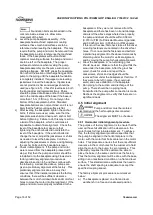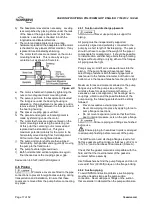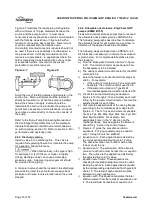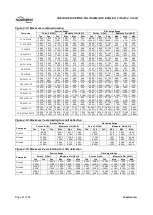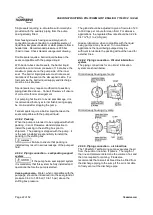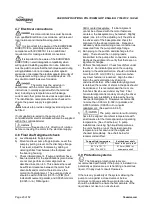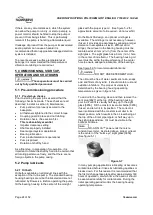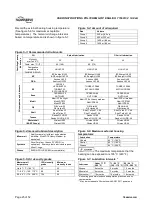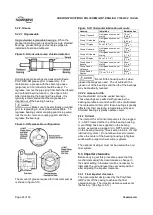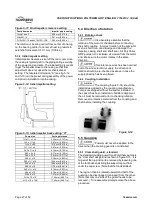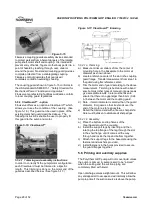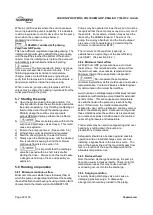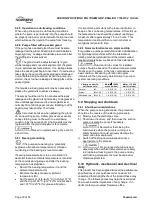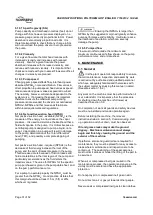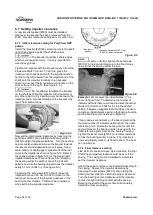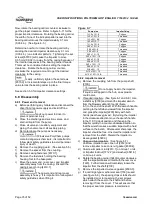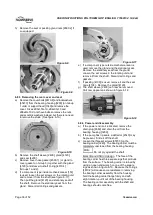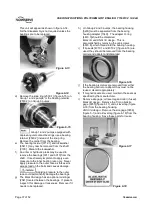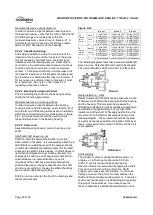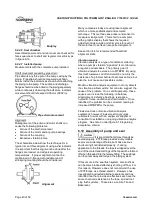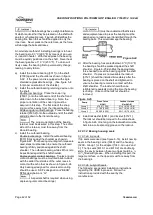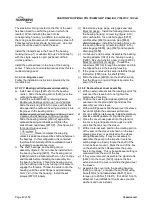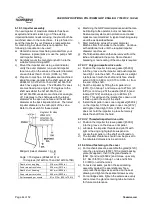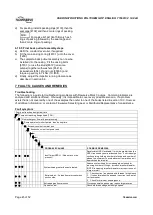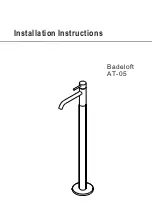
USER INSTRUCTIONS POLYCHEM GRP ENGLISH 71569132 12-04A
Page 30 of 52
flowserve.com
5.8.5 Operation in sub-freezing conditions
When using the pump in sub-freezing conditions
where the pump is periodically idle, the pump should
be properly drained or protected with thermal devices
which will keep the liquid in the pump from freezing.
5.8.6 Pumps fitted with a packed gland
If the pump has a packed gland there must be some
leakage from the gland. Gland nuts should initially be
finger-tight only. Leakage should take place soon after
the stuffing box is pressurized.
The gland must be adjusted evenly to give
visible leakage and concentric alignment of the gland
ring to avoid excess temperature. If no leakage takes
place the packing will begin to overheat. If overheating
takes place the pump should be stopped and allowed
to cool before being re-started. When the pump is re-
started, check to ensure leakage is taking place at the
packed gland.
If hot liquids are being pumped it may be necessary to
slacken the gland nuts to achieve leakage.
The pump should be run for ten minutes with steady
leakage and the gland nuts tightened by 10 degrees at a
time until leakage is reduced to an acceptable level,
normally 30 to 120 drops per minute. Bedding in of the
packing may take another 15 minutes.
Care must be taken when adjusting the gland
on an operating pump. Safety gloves are essential.
Loose clothing must not be worn to avoid being
caught up by the pump shaft. Shaft guards must be
replaced after the gland adjustment is complete.
Never run gland packing dry, even for
a short time.
5.8.7 Bearing monitoring
If the pumps are working in a potentially
explosive atmosphere temperature or vibration
monitoring at the bearings is recommended.
If bearing temperatures are to be monitored it is
essential that a benchmark temperature is recorded
at the commissioning stage and after the bearing
temperature has stabilized.
Record the bearing temperature (t) and the
ambient temperature (ta)
Estimate the likely maximum ambient
temperature (tb)
Set the alarm at (t+tb-ta+5) ºC ((t+tb-ta+10) ºF)
and the trip at 100 ºC (212 ºF) for oil lubrication
and 105 ºC (220 ºF) for grease lubrication.
It is important, particularly with grease lubrication, to
keep a check on bearing temperatures. After start up
the temperature rise should be gradual, reaching a
maximum after approximately 1.5 to 2 hours. This
temperature rise should then remain constant or
marginally reduce with time.
5.8.8 Normal vibration levels, alarm and trip
For guidance, pumps generally fall under a classification
for rigid support machines within the International
rotating machinery standards and the recommended
maximum levels below are based on those standards.
Alarm and trip values for installed
pumps should be based on the actual measurements
(N) taken on the pump in the fully commissioned as
new condition. Measuring vibration at regular
intervals will then show any deterioration in pump or
system operating conditions.
Vibration velocity
–
unfiltered r.m.s.
Motor 15 kW
mm/s (in./sec)
Motor > 15 kW
mm/s (in./sec)
Normal
N
3.0 (0.12)
4.5 (0.18)
Alarm
N
x 1.25
3.8 (0.15)
5.6 (0.22)
Shutdown trip
N
x 2.0
6.0 (0.24)
9.0 (0.35)
5.9 Stopping and shutdown
5.9.1 Shutdown considerations
When the pump is being shut down, the procedure
should be the reverse of the start-up procedure.
a) Slowly close the discharge valve
b) Shut down the driver, and then close the suction
valve to isolate the pump if necessary.
Remember that closing the
suction valve while the pump is running is a
safety hazard and could seriously damage the
pump and other equipment.
c) Switch off flushing liquid supplies at a time
appropriate to the process.
d)
For prolonged shut-downs and
especially when ambient temperatures are likely
to drop below freezing point, the pump and any
and flushing arrangements must be drained or
otherwise protected.
5.10 Hydraulic, mechanical and electrical
duty
This product has been supplied to meet the performance
specifications of your purchase order, however it is
understood that during the life of the product these may
change. The following notes may help the user decide
how to evaluate the implications of any change. If in
doubt contact your nearest Flowserve office.

